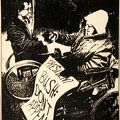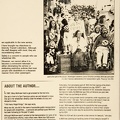WHEN IS TOO MUCH: "Helping" the Disabled
by Mary McKnew
Just as airplane pilots want assurance that a plane's steering wheel won‘t come off while flying over Europe, people utilizing a bus wheelchair lift deserve to expect that the lift will operate in a safe and predictable manner.
However, I have to admit that too much focus on “safety” issues has me a little worried.
To some transit officials, “safety” issues in providing transportation services for people with disabilities raise old stereotypes of helplessness and can quickly become a rationale for imposing paternalistic policies.
For example, here in Olympia, the local Intercity Transit Authority and the state's Department of General Administration are co-sponsoring a shuttle service between the capitol and downtown Olympia with routes passing other major states offices. With the local parking problem, this system is extremely convenient. From the beginning, all vans used in the service have been equipped with wheelchair lifts.
All this, of course, is very commendable.
So, what's the problem?
Unfortunately, the van's tie-down system, lack of grab-bars and driver policies reflect a paternalistic attitude towards disabled passengers by promoting dependence in the name of safety.
The tie-down system is one of the most primitive I have ever encountered. It uses straps to bind each of a wheelchair's four wheels to the floor in a rather intricate system that takes the driver approximately five minutes to accomplish. To tie-down a wheelchair, the driver must get on his or her hands and knees. Thus, it is not possible for even very mobile wheelchair users to accomplish this independently. However, once the straps are in place, none of the wheels will move even a centimeter. During this five minute routine, other van passengers wait outside (some glancing at their watches) until the driver folds the lift back in place and allows them to board.
After being strapped down, the driver then will place a seat-belt around the wheelchair user. Seat belts are not available for other passengers. If the wheelchair user decides to reject use of a seat belt, the driver will attempt (sometimes loud) persuasion, finally telephoning into the office to report that the passenger has refused use of the belt.
I use a wheelchair for mobility due to a low and incomplete spinal cord injury. I object to many of the features in the Intercity Transit system that, to me, are designed on the premise that people with disabilities will always need a lot of assistance from the driver. Although the driver should be trained and willing to provide assistance if it is requested, the system should be designed to promote maximum independence.
Most tie-down systems can be easily manipulated by most wheelchair uses with finger movement. Although some wheelchair users need a seat belt due to problems with balance, drivers should not assume they are needed by all such passengers. A policy that requires a driver to phone in to report a passenger's rejection of the seat belt is founded on the belief that people with disabilities are incapable of making sound decisions regarding their own safety.
Additionally, although grab-bars are located along the ceiling walls of other seats, none are available near the tie-down area. Thus, if the bus lurches while enroute, a wheelchair passenger has nothing to hold onto. I suppose this makes it more likely a wheelchair passenger will comply with the seat belt policy, recognizing that a passive restraint is better than none at all.
Intercity Transit has been providing paratranslt services to people with disabilities for a number of years. They have moved into the provision of mainline transportation services (i.e., access to the regular bus service) only recently. It appears that they have simply shifted their operating policies and procedures from one system to the other without considering if these are applicable to the new service.
I have brought my objections to Intercity Transit’s attention. Although the staff disagree with most, they are reconsidering others.
Safety is a concern to people who use wheelchair lifts.
However, we cannot allow it to become a convenient rationale for either eliminating the service or instituting restrictive policies that treat people with disabilities in a disparate manner from other passengers.
PHOTO (by Tom Olin): A large crowd marches downhill on a wide street. In the front row a little girl in a wheelchair (Jennifer Keelan) is pushed by her mother (Cindy). Beside them a woman in a motorized wheelchair (Diane Coleman) and a long skirt and white jacket has a sign behind her reading "we the people." Beside her a man in a manual wheelchair (Bob Kafka) with a big salt and pepper beard rolls along. In the row behind, between Bob and Diane, is a woman in a wheelchair (Mary McKnew) and a man who walks (Lannie Schuman) are visible and next to them another man marches behind Diane. Behind Jennifer and Cindy is Tari Susan Hartman. Rows of marchers go further and further back up the street to the top of the hill and presumably beyond.
Caption reads: Just to the right at the placard Washington residents Lannie Schuman and Mary McKnew participate in a San Francisco demonstration for transportation rights.
ABOUT THE AUTHOR...
In 1987, Mary McKnew tried to get arrested for the first time.
She sat in front of a San Francisco police van and refused to move. She sat in her wheelchair directly under the wheels of a bus and
refused to move. "I did many illegal things." she says wryly.
What she did, she did in the name of accessible public transportation for people with disabilities... a personal and political quest McKnew has been following for the past 12 years.
Although McKnew wasn't arrested at that demonstration (in spite of her civil disobedience efforts), many others were. More than 500 people organized by the American Disabled tor Accessible Public Transportation (ADAPT) marched through the streets oi San Francisco to the city hall to protest the continuing discriminatory policies supported by the American Public Transit Association (APTA). ADAPT has been a persistent thorn in the side of APTA for many years.
Fortunately, their persistence paid off. With the final signing of the Americans With Disabilities Act (ADA) expected any day, ADAPT—- and McKnew — will see many of their demands for fair, accessible transportation become reality. But McKnew says that just because you pass laws doesn't mean you quit being an activist.
"The ADA will bring private transit companies under regulations just like public ones," she says, "but just passing a law doesn't mean we
solve the problem. implementation is a whole other thing."
In part, McKnew was referring to the possibility that some private companies may reduce the seating capacity in some of their smaller
vehicles in order to side-step the accessibility requirements mandated by the ADA.
"What the ADA will do is provide a clear avenue for lawsuits," she says.
Is McKnew planning on handling some of those lawsuits herself? It may be too early to tell. Currently an executive policy assistant in the Office of the Governor, McKnew is also a second-year law student at the University of Puget Sound.
(This story continues in the original format on 571 but is included here in its entirety for ease of reading.)
- Created on
- Friday 12 July 2013
- Posted on
- Friday 3 July 2015
- Tags
- Access Living, accessible transit, ADAPT, APTA, Bob Kafka, buses, Cindy, Diane Coleman, Jennifer Keelan, Lannie Schuman, Marilyn Golden, Mary McKnew, Oylmpia WA, paternalism, safety, San Francisco, Tari Susan Hartman, tie-downs
- Albums
- Visits
- 3397
- Rating score
- no rate
- Rate this photo


0 comments